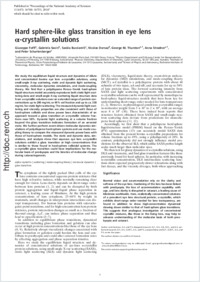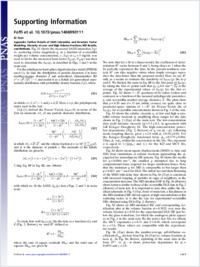Hard sphere-like glass transition in eye lens α-crystallin solutions
- Foffi, Giuseppe Laboratoire de Physique de Solides, UMR 8502, Université Paris-Sud, Orsay, France
- Savin, Gabriela Physics Department and Fribourg Center for Nanomaterials, University of Fribourg, Switzerland
- Bucciarelli, Saskia Physical Chemistry, Department of Chemistry, Lund University, Sweden
- Dorsaz, Nicolas Institute of Theoretical Physics, Ecole Polytechnique Fédérale de Lausanne, Switzerland
- Thurston, George M. School of Physics and Astronomy, Rochester Institute of Technology, Rochester, USA
- Stradner, Anna Physical Chemistry, Department of Chemistry, Lund University, Sweden
- Schurtenberger, Peter Physical Chemistry, Department of Chemistry, Lund University, Sweden
-
25.11.2014
Published in:
- Proceedings of the National Academy of Sciences. - 2014, vol. 111, no. 47, p. 16748–16753
English
We study the equilibrium liquid structure and dynamics of dilute and concentrated bovine eye lens α-crystallin solutions, using small-angle X-ray scattering, static and dynamic light scattering, viscometry, molecular dynamics simulations, and mode-coupling theory. We find that a polydisperse Percus–Yevick hard-sphere liquid-structure model accurately reproduces both static light scattering data and small-angle X-ray scattering liquid structure data from α-crystallin solutions over an extended range of protein concentrations up to 290 mg/mL or 49% vol fraction and up to ca. 330 mg/mL for static light scattering. The measured dynamic light scattering and viscosity properties are also consistent with those of hard-sphere colloids and show power laws characteristic of an approach toward a glass transition at α-crystallin volume fractions near 58%. Dynamic light scattering at a volume fraction beyond the glass transition indicates formation of an arrested state. We further perform event-driven molecular dynamics simulations of polydisperse hard-sphere systems and use mode-coupling theory to compare the measured dynamic power laws with those of hard-sphere models. The static and dynamic data, simulations, and analysis show that aqueous eye lens α-crystallin solutions exhibit a glass transition at high concentrations that is similar to those found in hard-sphere colloidal systems. The α-crystallin glass transition could have implications for the molecular basis of presbyopia and the kinetics of molecular change during cataractogenesis.
- Faculty
- Faculté des sciences et de médecine
- Department
- Département de Physique
- Language
-
- English
- Classification
- Physics
- License
- License undefined
- Identifiers
-
- RERO DOC 233232
- DOI 10.1073/pnas.1406990111
- Persistent URL
- https://folia.unifr.ch/unifr/documents/304063
Other files
Statistics
Document views: 70
File downloads:
- sav_hsl.pdf: 199
- sav_hsl_sm.pdf: 78

